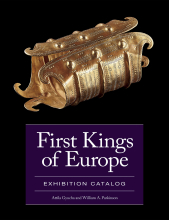Anthropomorphic pendant - Catalog No. 21
Record details
Patay 1958:Table XVII:4.
Gyucha, Attila and William A. Parkinson, 2023. Anthropomorphic pendant - Catalog No. 21 for First Kings of Europe: Exhibition Catalog. Version 1. Cotsen Institute of Archaeology Press. https://doi.org/10.25346/S6/3TDEVJ
To the east of the Tisza River, in the eastern part of the Great Hungarian Plain and in Transylvania, following the Neolithic tradition of the use of Spondylus shells and jewelry of colored stone beads, copper and gold objects started to be manufactured in large numbers during the Copper Age. These artifacts, such as heavy copper axes and gold anthropomorphic pendants that were fastened to clothing, were frequently deposited in hoards and burials (see Catalog Nos. 19, 20, 23, and 24). The raw materials were probably supplied from Transylvanian mines. This gold pendant demonstrates the social and economic status of the owner.
Hargita Oravecz and Katalin T. Biró
